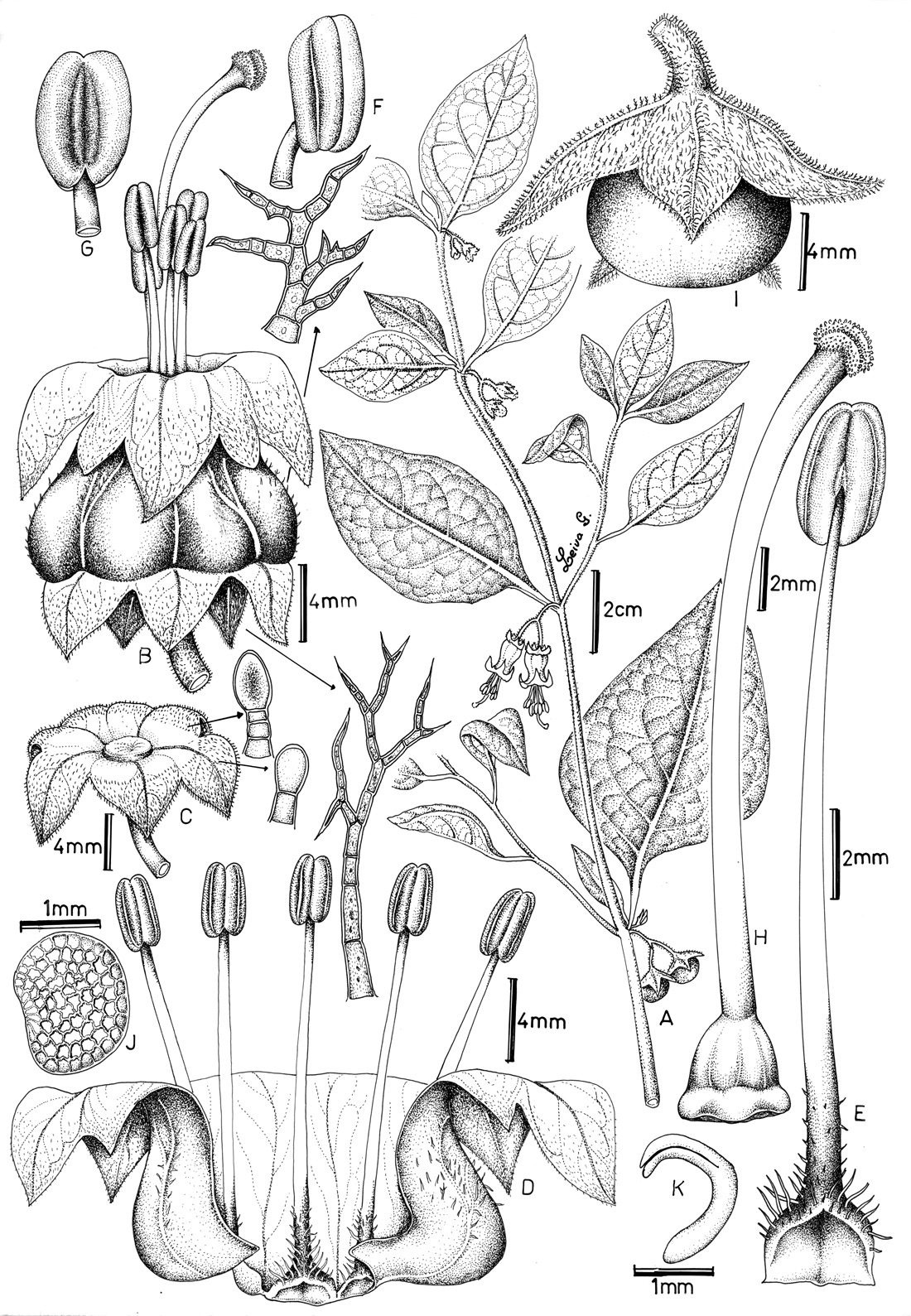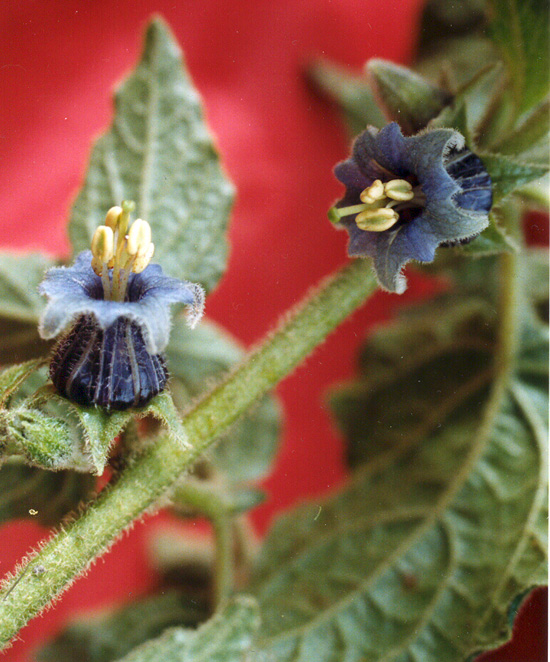(Mione, Leiva & Yacher 737, photo by Thomas Mione).

Jaltomata yacheri Mione & S. Leiva |
Peru |
revised 15 Apr 2014 |
| The information on this page may be cited as a personal communication with Thomas Mione, Biology Department, Central Connecticut State Uiversity, New Britain, CT 06050-4010, USA and Segundo Leiva G., Universidad Privada Antenor Orrego, Av. América Sur 3145, Casilla postal 1075, Trujillo Peru |
Novon 17: 49-58. 2007 |
Link to Jaltomata homepage |
Link to the Jaltomata of Cajamarca, Peru |
Link to the Jaltomata of northern Peru |
Link to local names including of this species |
Link to list of Jaltomata species having edible fruits, including this species |
| Figure 1. Anthers of the flowers on the left and right are undehisced; anthers of the middle flower have dehisced (Mione, Leiva & Yacher 737, photo by Thomas Mione). |
 |
| Figure 2. Jaltomata yacheri Mione & S. Leiva. --A. Branch with leaves, inflorescence and fruit. --B. Flower, lateral view. --C. Calyx, oblique view. --D. Corolla dissected to show the insertion of the stamens. --E. Stamen, ventral view. --F, G. Anther and distal portion of filament, lateral and dorsal views, respectively. --H. Gynoecium including basal disk. --I. Berry with calyx, lateral view. --J. Seed. --K. Embryo of the seed. Scale bar of E also applies to F & G. (S. Leiva et al. 2372, drawn by S. Leiva G.). |
| Character | Description | Figures on this page |
Habit & Height |
Suffrutescent, to 1.5 m | |
Branches, young |
green, terete, villous with dendritic hairs that are not gland-tipped | |
older |
terete, glabrous, green | |
Leaves, size |
geminate, the blade to 8 X 4.6 cm, somewhat coreaceous | |
| shape | the blade ovate, the apex acute, the base rounded to somewhat truncate, the margin entire | |
| hairs | abaxially and adaxially pilose with finger or dendritic hairs, the margin ciliate | |
| petiole | to 1.8 cm | |
Inflorescence |
axillary or less commonly arising from a stem dichotomy, 2- to 3- (4 including buds) flowered | |
peduncle |
6 to 10 mm, terete, green and lanate | |
pedicel |
5 to 10 mm, terete, green and lanate | |
Calyx at flowering |
green, to 18 mm across, the lobes triangular, abaxially velutinous with dendritic hairs, adaxially with glands, the margin ciliate | |
| shape / position when flowering | rotate to reflexed | 1,2,3,4,6,7 |
| at fruit maturity | green and 18 to 20 mm across | |
Corolla color |
bright blue-purple | |
shape and size |
urceolate with a reflexed to revolute limb, the tube 8 -- 13 mm long, the base 10 -- 12 mm in diameter, with 5 cavities full of nectar between the expanded bases of the stamens, the limb 18 to 20 (-25) mm across including lobes | |
lobes/lobules |
10-lobed: 5 lobes alternating with 5 lobules, all triangular, | |
hairs
|
the tube glabrous within, abaxially with simple, forked and dendritic hairs mostly on the main veins; adaxially pilosulose with finger hairs 0.2 to 0.3 mm, the terminal cell of which is rounded and densely staining; the margin ciliate | |
Stamen length including anther |
13 -- 17 mm, varying in length within a flower prior to anther dehiscence |
|
| length stamens exserted beyond distal end of corolla (applicable if corolla has a well-defined tube) | exserted 5--14 mm beyond the mouth of the corolla | |
| yes | ||
| base expanded laterally? | yes, as viewed ventrally | 2E |
| filaments | filaments dark purple at base, otherwise pale-green, pubescent on proximal 20--25% of the length with unpigmented simple hairs | |
| anther color | yellow | 1 |
| anther size | 2.4 -- 3.3 mm | |
| anther mucronate/mucronulate | not mucronate | |
| insertion of filament into anther | 2E,2F,2G | |
| anthers of a flower open simultaneously? | probably not: the 5th flower in figure 3 (below) may show nonsimultaneous anther dehiscence, with the anthers of the longer stamens dehiscing first | 3 |
| pollen quantity per flower | 117,700 (Mione et al. 737) 274,000 (Mione et al. 670) |
flowers collected in Peru (not grown for study), counts by Emmett P. Varricchio |
| pollen grain size | ||
| corona | no | |
Stigma |
capitate, bilobed, green, 0.84--1.5 mm, the papillae 60--90 µm long |
|
Style |
1.5--2.0 cm, pale-green | |
Ovary |
disk girdling base of ovary | |
Ovules per ovary |
184 (n = 1, Mione et al. 737) 230 (n = 1, Mione et al. 670) |
flowers collected in Peru (not grown for study), counts by Thomas Mione 2013 |
Nectar |
translucent | field observations, 1999 and 2007 |
| Herkogamy | yes | 1,2,3,4 |
| Protogyny | yes (field notes Mione et al. 737) | |
Fruit color (at maturity) and size |
subspherical, orange and to 11 mm across at maturity, the style somewhat persistent | |
Seeds per fruit |
55 to 108 per berry | |
Seed Size |
reniform | |
Chromosome number |
no data |
|
Growability in Connecticut, USA |
no data |
|
How long does it take from flower to ripe fruit? |
no data |
|
Self-Compatible? |
no data |
|
Seed Germination |
no data |
|
Ratio of pollen to ovules |
640 ((n=1 flower, Mione et al. 737) 1191 (n =1 flower, Mione et al. 670) |
|
| Character | Description of Jaltomata yacheri | Figures on this web page |
| Figure 3. Stamens of Jaltomata yacheri elongate while the flower is open, and then anthers dehisce. The style may also elongate while the flower is open. From left to right: developmental sequence from protogynous to functionally hermaphroditic (Mione et al. 737, photo by Thomas Mione). |
|
Jaltomata yacheri is similar to J. contumacensis. J. yacheri grows to 1.5 m high, has a bright blue-purple corolla, the corolla limb becomes revolute, the calyx is reflexed during anthesis, and the anthers are not mucronate. Distribution, ecology, etymology and uses: Jaltomata yacheri is known only from Peru, department Cajamarca, province Hualgayoc, in the vicinity of the city of Hualgayoc, where it is locally common on the side of the road between 3,460 to 3,515 m elevation. The specific epithet was chosen by T. M. and S. L. G. to honor Dr. Leon Yacher.
|
| Figure 4. Underside (abaxial face) of leaf showing on right, photo by Leon Yacher |
| Figure 5. Fruits (immature) of Jaltomata yacheri (Mione et al. 737, photo by Thomas Mione). |
| Figure 6. Mione et al. 737, photo by Leon Yacher. |
Table 2. Specimens studied, all Peru, all Department Cajamarca:
| Province | Locality | elevation m |
habitat | date |
collector | data entry |
| TYPE: Hualgayoc | near Hualgayoc | 3460 |
roadside | 18 June 1999 |
Mione, S. Leiva G. & L. Yacher 670 (holotype, MO; isotypes, F, HAO) | April 2007 |
| Paratype: Hualgayoc | near Hualgayoc | 3460 |
roadside | 18 June 1999 |
S. Leiva G., T. Mione & L. Yacher 2372 (CORD, HAO) | April 2007 |
| Hualgayoc | entering Hualgayoc coming from Bambamarca, 6 45.741, 78 36.136 |
3515 |
roadside | 19 March 2007 |
Mione, S. Leiva G. & L. Yacher 737 | April 2007 |
| Hualgayoc | entering Hualgayoc coming from Bambamarca, 6 45.741, 78 36.136 |
3515 |
roadside | 19 March 2007 |
S. Leiva G., T. Mione & L. Yacher 3640 (CORD, HAO) | April 2007 |
 |
Figure 7. Flowers are evidently protogynous: |
| Figure 8. Thomas Mione handling Jaltomata yacheri plant, photographed by Leon Yacher, Mione et al. 737. |
Suffrutex; laminae ad 8 x 4.6 cm, aliquantum coriaceae, piliferae simplices vel dendriticae; inflorescentia 2--3 (-4)-flora; corolla urceolata, cyanea-purpurea, limbus 18-20 (-25) mm latus, reflexus, lobis 10; stamina 13--17 mm, antherae 2.4--3.3 mm; styli 1.5--2 cm.